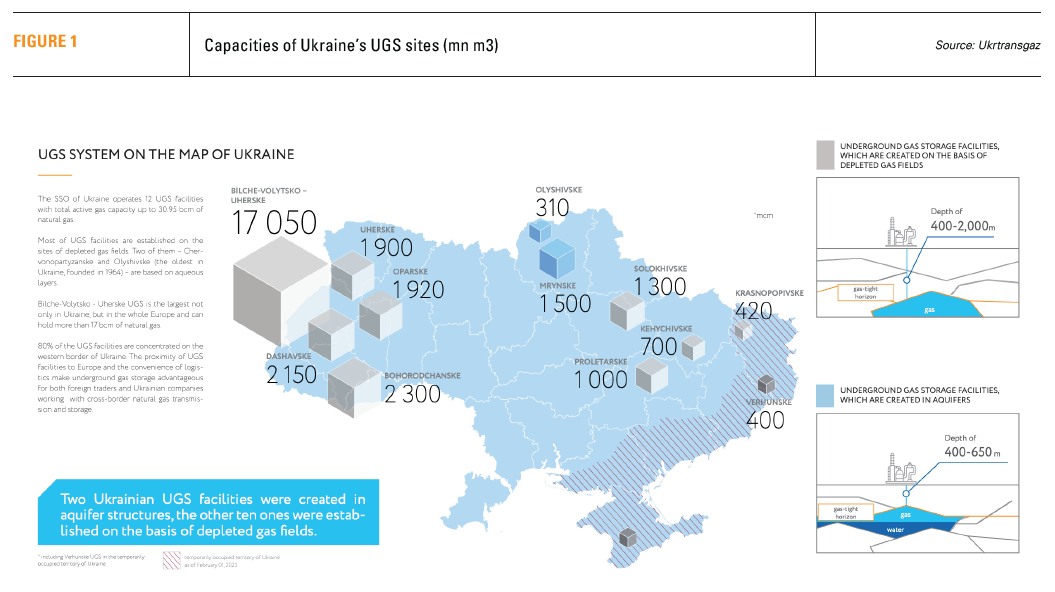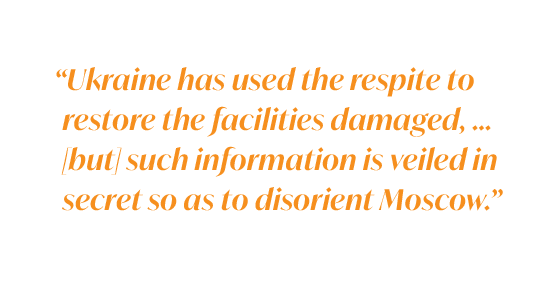Will Ukraine survive in the cold? [Gas in Transition]
Ukraine's energy sector is bracing for another difficult wartime winter. Most of the power plants were hit by Russian missiles last winter, and Ukraine's largest nuclear plant was occupied and ceased operation. This caused severe power shortages with scheduled and unscheduled blackouts across the country, until the grid was stabilised last February. The hydrocarbon infrastructure was not spared either. Ukraine fears that Moscow will repeat massive missile strikes on the energy facilities in the coming winter. If so, the situation may get worse than a year ago, as not all the facilities damaged have been repaired. On the upside, Ukraine will not be caught unawares this time.
A winter on the brink
When the large-scale invasion began in February 2022 and many industrial power consumers were stopped, the Ukrainian government planned to boost power exports at the expense of excessive generation capacities. The hopes were dashed by the occupation of Ukraine's and Europe's largest nuclear plant in Zaporizhzhya, which was subsequently stopped by autumn 2022. What's more, there was a brief period when the Russian troops were dangerously close to another nuclear plant, in Yuzhnoukrainsk. The Russians were eventually repelled, and Ukraine remained in control of three nuclear plants.
 The real nightmare began in October 2022, after the first wave of missile strikes on the power infrastructure on October 10-11, when Russia used more than 100 rockets and dozens of Iranian drones. Ukrainian President Volodymyr Zelensky tweeted on October 19, 2022, that 30% of Ukraine's power plants had been destroyed. Those were mainly thermal power plants. What remained of power exports to the EU was stopped, and the authorities began the rolling blackouts which continued till mid-February. Businesses rushed to import fuel-powered generators. Apparently hoping that Ukraine would capitulate, Russia continued its massive strikes. At one point last November, Ukraine was on the brink of a full blackout amid an emergency shutdown of all the nuclear reactors.
The real nightmare began in October 2022, after the first wave of missile strikes on the power infrastructure on October 10-11, when Russia used more than 100 rockets and dozens of Iranian drones. Ukrainian President Volodymyr Zelensky tweeted on October 19, 2022, that 30% of Ukraine's power plants had been destroyed. Those were mainly thermal power plants. What remained of power exports to the EU was stopped, and the authorities began the rolling blackouts which continued till mid-February. Businesses rushed to import fuel-powered generators. Apparently hoping that Ukraine would capitulate, Russia continued its massive strikes. At one point last November, Ukraine was on the brink of a full blackout amid an emergency shutdown of all the nuclear reactors.
All told, Russia targeted Ukraine's energy facilities with over 1,200 missiles during the last cold season, damaging 43% of the transmission lines and all the thermal and hydroelectric plants, according to the Ukrainian energy ministry. Ukraine lived through the winter thanks to its nuclear plants and emergency power supplies from the EU, which began in January. The Russians did not spare Ukraine's gas infrastructure either, although losses there were less significant, estimated at over $1bn by the state oil and gas company Naftogaz Ukrainy last February. Ukraine's largest oil refinery, based in Kremenchuk, has been hit repeatedly since February 2022. In June 2023, one of Ukraine's main hydropower plants, the Kakhovska on the Dnieper, was blown up.
Air defences beefed up
Ukraine hopes that if Russia repeats the strikes on the power infrastructure, it will be better protected by the air defences this time. While Ukraine managed to shoot down only about half of the rockets detected during the first strikes a year ago, by last spring the effectiveness of Ukraine's air defences grew to 75-90%. They were beefed up by the systems supplied by the West, such as the American Patriot, the American-Norwegian NASAMS, the German IRIS-T and Gepard, the Franco-Italian SAMP/T, and the old but still effective American Hawk, while some of the old Soviet-designed air defence systems have been adapted to use Western projectiles.
Most recently, the Ukrainian authorities announced that one or two more Patriot batteries will be supplied soon, in addition to the two batteries delivered by the US and Germany last spring. Ukraine has been using the Patriots at its disposal mainly to protect the skies over the capital Kyiv. Ukraine also hopes to receive more Gepards, effective against the drones which Russia has been using more increasingly. In the meantime, Russia since last spring has been using fewer of its deadly ballistic and cruise missiles, compared to last year. It is feared in Ukraine that Russia has been sparing the more effective rockets, while testing the air defences with drones and replenishing the rocket arsenals for massive strikes to be resumed when frosts begin. In the meantime, Ukraine lacks jet fighters to help its surface-to-air missile systems.
Back from the ashes
Ukraine has used the respite to restore the facilities damaged. Not much has been reported about the process and its results in the local media, and statements from officials on the preparation of the power sector for the winter have often been contradictory. Such information is veiled in secret so as to disorient Moscow, as the head of the grid operator Ukrenergo, Volodymyr Kudrytsky, admitted last July.

Ukrainian Infrastructure Minister Oleksandr Kubrakov mentioned in a Facebook post on July 30, following a meeting with regional government representatives, that almost 100% of the thermal power plants dama
ged by Russia had been restored, as well as over 65% of the more than 700 heating supply facilities that had been damaged.
In October, Kudrytsky told the Voice of America that not all the facilities damaged have been restored. He said restoration works would continue over the winter. He noted that Ukraine received several billion dollars from abroad for the purpose, of which grants accounted for 35%. Kudrytsky revealed that Ukraine was erecting certain unique protective facilities for the energy infrastructure. He said Ukraine would not live through the winter without power imports in any case. The CEO of Ukraine's largest private energy company DTEK, Maksim Timchenko, told a press conference on October 11 that DTEK restored whatever could be restored, stored up equipment reserves, and protected its power plants as best as it could.
Ukraine has thus far in 2023 received as humanitarian assistance almost 6,000 tonnes of energy equipment from 120 firms, government agencies and NGOs representing 34 countries, the Ukrainian Energy Ministry said on Facebook on November 23.
The restoration works and foreign aid have apparently not been sufficient, as when temperatures fell below zero for several days this November, Ukraine began to experience power shortage and resorted to emergency electricity imports.
Enough gas and fuel
Ukraine has not been doing badly as far as natural gas storage is concerned. For the 2022-2023 heating season, which was climatically warmer than usual, about 14bn m3 of gas had been stored, including about 1bn m3 imported from the EU. Less than 6bn m3 of gas was eventually taken from the underground storage facilities. The government instructed Naftogaz to store 14.7bn m3 of gas for this winter. Eventually more than 16bn m3 of gas has been stored, although 2-3bn m3 of that has been gas belonging foreign traders which have been using Ukraine's gas storage facilities because those in the EU have been almost full.
Given the thus far warm autumn, Ukraine may accumulate yet more gas by the winter frosts. Ukraine has no plans to import gas for the time being, relying on storage and domestic production, which is expected to slightly grow this year from the 18.5bn m3 trough of 2022. Ukraine has not been buying gas from Russia since 2015. Its gas storage facilities are relatively safe, as more than 25bn m3 of Ukraine's underground storage capacity out of the available 31bn m3 is located in the western areas, far from the battlefields, according to Naftogaz. The gas production facilities are less safe, as they are located mainly in the eastern regions of Kharkiv and Poltava, which are much closer to the frontlines.
Ukraine has experienced no shortage of gasoline, diesel or LPG since summer 2022. They were in short supply for several months in spring 2022, as it took time for local fuel traders to get accustomed to the absence of imports from Russia and Belarus and to the destruction of Ukraine's own refineries by Russian missiles. Since then, Ukraine has heavily relied on fuels imported from the EU. One of the consequences has been LPG shortage this November, when Polish hauliers staged a strike, blockading the border crossing points with Ukraine.



